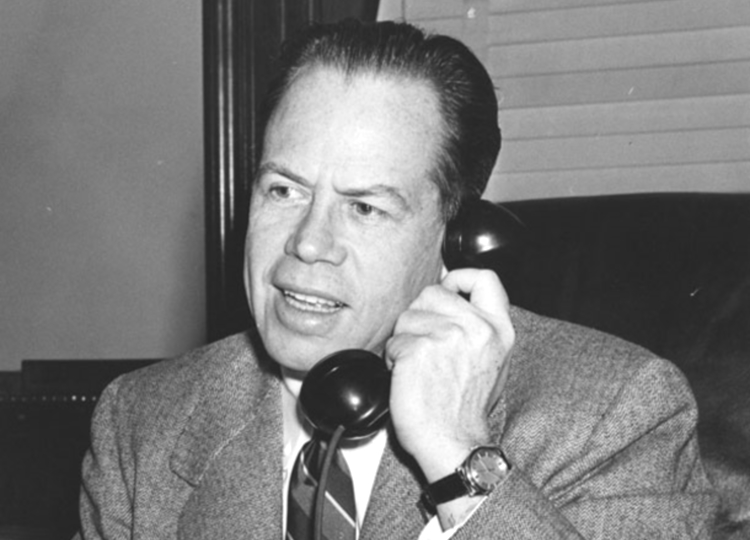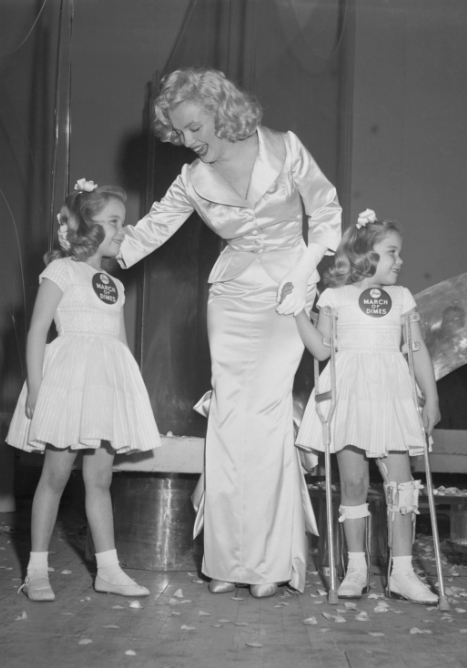An Accidental Homicide
Many years after the fact, sometime around 1985, Sgt Clemmons offered some controversial testimony: he discovered Mrs. Murray operating Marilyn’s washing machine and dryer on the morning of August the 5th. For 1992’s The Marilyn Files, Sgt Clemmons reported to Robert Slatzer that Mrs. Murray was in another section of the house doing laundry, washing sheets: he could hear that the laundry equipment was going (Slatzer Files 6). During interviews with Donald Wolfe in 1993, Sgt Clemmons reported that he searched through the sparsely furnished house, which seemed rather small and inelegant for the home of a film star. The sergeant found Marilyn’s housekeeper in the service porch off the kitchen, where both the washer and the dryer were running. She appeared agitated as she folded a stack of laundry on the counter (Wolfe 11). Considering that strange activity, the sergeant reached an interesting conclusion: Mrs. Murray was obviously destroying evidence.
However, Sgt Clemmons did not mention Eunice Murray’s domestic activities to Robert Slatzer in 1974 when Marilyn’s counterfeit second husband interviewed the former policeman; and Sgt Clemmons did not mention the laundry story in 1982 when he appeared before the Los Angeles County Board of Supervisors alongside Slatzer, Jeanne Carmen and Samir Muqaddin. Additionally, none of the filed police reports denoted, and none of the other individuals present that morning mentioned, Mrs. Murray’s domestic activity. Odd to say the least. That domestic detail originated belatedly with Sgt Clemmons. His assertion has never been corroborated; and, incidentally, Marilyn’s hacienda did not have a service porch. And too, not one photograph of Marilyn’s appliances or her service porch, along with photographs of Mrs. Murray’s evidence eradicating domestic activities, have ever appeared, implying that those photographs were never taken; and considering the monumental importance of those machines and those activities, an inquiring mind is left to only wonder why?
The Eunice-Was-Washing-Marilyn’s-Sheets story was the corner stone which totally supported Donald Spoto’s 1993 alternate theory of why and how Marilyn died; and when I first read the renown biographer’s theory, that an ill-advised enema administered by Eunice Murray on orders from Dr. Greenson accidentally precipitated Marilyn’s death, it occurred to me that life’s odd way of leading the rich and famous to ironic and yet mundane endings argued in favor of Mr. Spoto’s theory; and when I read that a police officer, Sgt Jack Clemmons, had observed Mrs. Murray operating a washing machine when he arrived at Fifth Helena that morning, obviously destroying evidence, for me the mystery of Marilyn Monroe’s untimely death had finally been solved. I completely accepted Mr. Spoto’s theory then; but I now realize that his theory also presents a particular set of problems, the least of which is Sgt Clemmons belated, undocumented and unsubstantiated testimony.
The demanding logistics of moving Marilyn’s body from her bed and depositing it somewhere else in her house, removing her soiled sheets, applying fresh sheets, cleaning Marilyn’s body and then returning her to her bed seems much too daunting a task for Mrs. Murray and Dr. Greenson. They might have been peculiar personalities, but macabre ghouls? And while I am not a pathologist, I suggest that grasping Marilyn’s body as required to move it, as required to accomplish changing her bed’s sheets and then returning her body to her bed, would have deposited evidence induced post mortem upon it; and Dr. Noguchi’s close, magnifying glass inspection of Marilyn’s body did not reveal any such evidence.
Additionally, at what time did Mrs. Murray administer the ill-advised, deadly enema? Just minutes before Marilyn’s death or did Marilyn die during the enema’s administration? Donald Spoto did not precisely specify when Mrs. Murray administered the drug-laced enema. The eminent biographer only insinuated that Peter Lawford’s second telephone call between 7:30 PM and 7:45 PM on August the 4th found Marilyn slipping over the edge of consciousness toward death (Spoto 584).
Joe DiMaggio, Jr. spoke with Marilyn at approximately 7:20 PM, and he reported that Marilyn did not sound drugged or drunk when he spoke to her. So, that being the case, the fatal enema must have been administered between the junior DiMaggio’s brief conversation with Marilyn at approximately 7:20 PM and Lawford’s brief conversation with her at 7:45 PM, creating the inference that Marilyn died between 8:00 PM and 8:30 PM; however, that early time of death neither fits with Marilyn’s liver temperature at the time of her autopsy nor Natalie Trundy’s testimony inferring that Marilyn died around 11:00 PM; and too, if Marilyn had died almost immediately following the enema’s administration, the level of drug concentrations in her blood and liver would not have been attained. Needless to say, it is difficult to reconcile the delay of an hour or even a few hours between the enema’s apparent administration, leading to Marilyn’s slide toward death, and Mrs. Murray’s early morning sheet washing activities.
Besides, why would the perpetrators of the accidental homicide have summoned the police just at the moment Mrs. Murray began to wash Marilyn’s sheets? To have made such an ill-timed telephone call to the police is illogical and nonsensical. Dr. Greenson and Mrs. Murray most certainly would have completed removing any evidence relative to Marilyn’s accidental homicide before alerting the men with badges. Furthermore, whatever Mrs. Murray attempted to remove from Marilyn’s sheets, the expelled enema liquid or liquefied and evacuated solid waste, most certainly would have bled through the sheets onto the mattress, leaving obvious evidence, and certainly would have produced a foul odor. Not one person who appeared at Marilyn’s hacienda on the morning of August the 5th mentioned any foul odors or remotely suggested that Marilyn’s mattress had been stained by fecal matter. At any rate, the probability that Marilyn was killed accidentally by Eunice Murray and an enema bag is more than remote. And too, I must repeat here: Marilyn’s autopsy report indicated the presence of fecal matter in her colon.
It is logical and more than realistic to assert, that any enema ordered by Dr. Greenson and administered by Eu-nice Murray, certainly and obviously, would have been administered in Marilyn’s nearby toilet; and that most certainly being the case, why would Marilyn’s sheets need to be washed?
To close the loop on the washing machine fable, it has been conclusively disproven by Marilyn biographer, Gary Vitacco-Robles, who also wrote the in-depth investigation of Marilyn’s life in Brentwood, Cursum Perficio: Marilyn Monroe’s Brentwood Hacienda: The Story of Her Final Months, not only an in depth investigation of Marilyn’s residency on Fifth Helena, but also an investigation of the Fifth Helena residence itself. Vitacco-Robles reported that Marilyn’s house was not equipped with built-in washing machine connections or a dryer vent, which is understandable since her hacienda had been constructed in 1929, about 25 years before automatic washers and dryers became fixtures in American homes. Other acknowledged Marilyn Monroe experts, April VeVea for in-stance, have written about and discredited Sgt Clemmons’ story. According to both Vitacco-Robles and VeVea, Marilyn did not even own a washing machine or a dryer. Marilyn used a professional laundry service, proven by extant receipts. Also, the only section of the house where a washer and dryer could have been located was the kitchen; and drawings commissioned by Marilyn for her kitchen remodeling effort do not indicate a washing machine or a dryer in the existing kitchen area; and those drawings do not indicate the service porch mentioned by Sgt Clemmons and reported by Donald Wolfe. Furthermore, the list of new appliances Marilyn intended to purchase for her remodeled hacienda and new updated kitchen did not include a washer or a dryer. Also, please refer to the next section and subsection, the one dedicated to the Jeanne Carmen and Fred Otash murder orthodoxy. There you will find a floor plan of Marilyn’s hacienda as it was in 1962. As noted, the house did not contain a laundry room or a service porch.1Marilyn: A Day In The Life.
Washer and Dryer.
“Washers and Dryers and Bears, Oh My!”
<https://marilynadayinthelife.com/washer-and-dryer/>
Finally, during the many years following Marilyn’s death, one of the testifiers offered testimony in an attempt to prove that Marilyn did not ingest an overdose of barbiturates: the water supply to Marilyn’s house had been stopped due to the ongoing remodeling. Maybe Norman Jefferies, who was involved in remodeling Marilyn’s hacienda, or maybe Robert Slatzer, so testified and also began that myth; but regardless of who offered that testimony, it clearly contradicted Sgt Clemmons’ assertion about Eunice Murray destroying evidence with the washing machine. Obviously, if the water supply to the house had been cut off, then Mrs. Murray could not have been operating a washing machine; but if she was operating a washing machine, then certainly Marilyn had access to running water.


